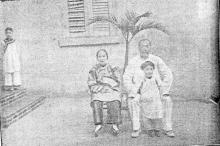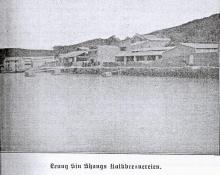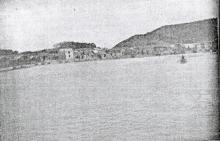Limekiln Factories on Peng Chau [????- ]
Primary tabs
I found some informations on Peng Chau and will post my pictures of Peng Chau from 1904.
Informations I copied from:
http://greenpengchau.org.hk/theme.php?page_id=LimeKiln&lang=e
"Limekiln Factories
As one of the four main local primary industries in the 19th century, the limekiln industry was significant in modern Hong Kong history. Though no specific record for the commencement of Peng Chau's limekiln industry has been found, it was the biggest of its kind in Hong Kong in the early 19th century with a total of 11 plants operating.
 Historical records showed that as early as the Tang Dynasty (AD618-907), there were already Han settlers on Hong Kong's outlying islands using oyster, bivalve shells and corals as raw materials for refining into lime for use as materials to build houses. Besides, lime had other applications, as fertilizer (to balance the PH and oxidation in the soil), pesticide, herbicide, sugar refining, boat surface mending, paper manufacturing, dying, etc..
Historical records showed that as early as the Tang Dynasty (AD618-907), there were already Han settlers on Hong Kong's outlying islands using oyster, bivalve shells and corals as raw materials for refining into lime for use as materials to build houses. Besides, lime had other applications, as fertilizer (to balance the PH and oxidation in the soil), pesticide, herbicide, sugar refining, boat surface mending, paper manufacturing, dying, etc..
 However, around the mid 1950s decline of the lime industry was brought about by mass production from Green Island Cement, and at the same time China and Japan also started trading white ash in Hong Kong, making prices too competitive and severely affecting the local industry. Later further impact by industrial and property developments for demand on coastal land led limekiln factories to close down one after another, turning their existence into history. Nowadays the majority of Hong Kong's limekilns have disappeared, and the Shing Lee (Triumph) Limekiln factory in South Bay on Peng Chau is the only surviving site which is under study by the Antiquities and Monuments Office to be listed as a protected heritage.
However, around the mid 1950s decline of the lime industry was brought about by mass production from Green Island Cement, and at the same time China and Japan also started trading white ash in Hong Kong, making prices too competitive and severely affecting the local industry. Later further impact by industrial and property developments for demand on coastal land led limekiln factories to close down one after another, turning their existence into history. Nowadays the majority of Hong Kong's limekilns have disappeared, and the Shing Lee (Triumph) Limekiln factory in South Bay on Peng Chau is the only surviving site which is under study by the Antiquities and Monuments Office to be listed as a protected heritage.
 To a certain extent the lime industry exerted negative impact on Hong Kong's natural environment by consuming large amount of fuel, which came conveniently and economically from chopping down local trees those days. There was definite damage on native plants and the eastern part of Lantau Island bore the brunt, needless to mention about air pollution caused by the burning process. Moreover, extracting huge amount of coral from the sea for raw materials also damaged marine ecology. The fading of the lime industry therefore brought about a positive impact on the balance of land and marine ecology in Hong Kong"
To a certain extent the lime industry exerted negative impact on Hong Kong's natural environment by consuming large amount of fuel, which came conveniently and economically from chopping down local trees those days. There was definite damage on native plants and the eastern part of Lantau Island bore the brunt, needless to mention about air pollution caused by the burning process. Moreover, extracting huge amount of coral from the sea for raw materials also damaged marine ecology. The fading of the lime industry therefore brought about a positive impact on the balance of land and marine ecology in Hong Kong"





Comments
Limekiln Factories
Thanks Christoph. I think of Peng Chau as a sleepy place, so it's a surprise to read that it had this industrial past.
Regards, David